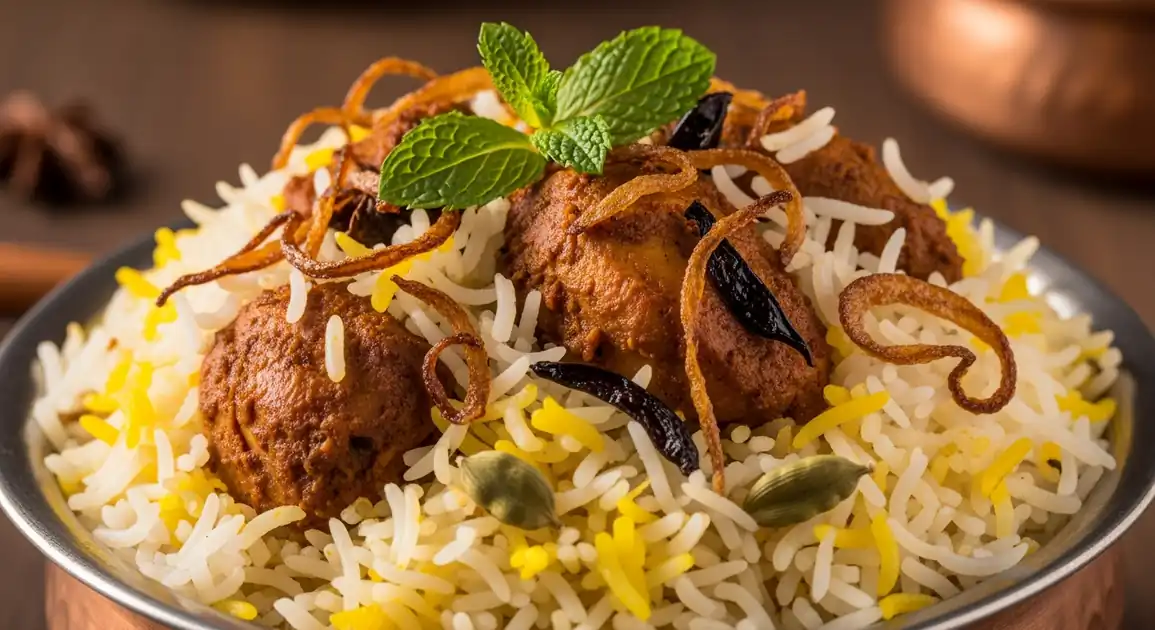Biryani
बिरयानी

Description
Biryani is a beloved dish across India, considered a meal in itself and often served during celebrations. While its roots are Mughlai, numerous regional variations have evolved, each with unique ingredients, spice levels, and cooking methods. It's widely available, from humble street stalls to upscale restaurants.
Dietary Information
Serving information
Serving style
Often served directly from the cooking 'handi' onto a plate. Accompanied by Raita (yogurt dip, often with onion/cucumber) and sometimes Salan (gravy, esp. Hyderabadi style) or a simple onion salad. Eaten with a spoon or the right hand.
Quick facts
Lunch: 12 PM - 3 PM. Dinner: 7 PM - 11 PM. Street stalls may operate mainly during lunch peaks or evenings. Some famous spots in cities like Delhi or Hyderabad stay open late.
Safety Tips
What to Look For
-
Served steaming hot
Heat is crucial for both taste and safety, especially for rice dishes. Ensure the Biryani is served directly from a hot pot, releasing steam.
-
Busy vendor with high turnover
Indicates the Biryani is freshly made and hasn't been sitting at unsafe temperatures for long.
-
Separate, fluffy rice grains
Properly cooked Biryani shouldn't be mushy or clumped, indicating good quality rice and cooking technique. This also indirectly relates to freshness.
-
Pleasant, aromatic smell
Authentic Biryani has a rich, inviting aroma. Any sour or unpleasant smell is a major red flag.
-
Clean serving area and utensils
Observe the general hygiene of the stall, the state of the 'handi', and the cleanliness of serving spoons and plates.
What to avoid
-
Lukewarm or cold Biryani
Rice stored at improper temperatures is a high risk for bacterial growth. Never eat lukewarm Biryani from street vendors.
-
Visible flies or pests around the food stall
A clear sign of poor hygiene standards.
-
Mushy, lumpy, or broken rice
Can indicate overcooking, poor quality rice, or that the Biryani is old and has been reheated improperly.
-
Unpleasant or sour smell
Indicates spoilage. Do not consume.
-
Visibly dirty 'handi', serving spoons, or plates
Increases the risk of cross-contamination and illness.
Price information
Price range
Budget tips
- Street stalls and basic eateries offer the most affordable plates (approx. 100-250 INR).
- Prices increase significantly in mid-range and fine-dining restaurants (300-800+ INR).
- Vegetable Biryani is usually cheaper than meat versions.
- Portion sizes can be large; check if a 'half plate' option is available.
Value indicators
- Generous portion of meat or vegetables.
- Use of good quality long-grain Basmati rice.
- Rich aroma and balanced flavors.
- Served fresh and hot, ideally from a 'dum' cooked pot.
Where to Find This Dish
Major Cities (Delhi, Hyderabad, Lucknow, Kolkata)
Each city is famous for its specific style of Biryani, found in dedicated restaurants and historic food areas.
Old Delhi, Charminar (Hyderabad), Aminabad (Lucknow), Park Street Area (Kolkata)
Lunch, Dinner
Muslim Neighborhoods
Often the best places to find authentic, traditional meat Biryanis.
Local Mosques, Marketplaces in Muslim areas
Lunch, Dinner, Late Night (during festivals like Ramadan/Eid)
Busy Market Areas
Street stalls selling Biryani are common in markets catering to shoppers and workers.
Commercial centers, Railway stations
Lunchtime, Evening
Vendor Tips
- Specify Chicken, Mutton, or Veg when ordering.
- Ask about the spice level if you have preferences ('Zyada spicy mat karna' - don't make it too spicy).
- Look for places specializing in Biryani or known regional cuisines.
- Observe if they are cooking in 'dum' style (sealed pots).
How to Order
Regional Variations
-
Hyderabadi Biryani
(Hyderabadi Biryani)
Known for its spiciness, use of 'kacchi' (raw meat cooked with rice) or 'pakki' (cooked meat layered with rice) methods, often served with Mirchi ka Salan (chili gravy) and Raita.
-
Lucknowi Biryani (Awadhi Biryani)
(Lucknowi Biryani / Awadhi Biryani)
Milder and more subtly spiced than Hyderabadi, focusing on aroma and fragrance ('khushboo'). Uses the 'pakki' method.
-
Kolkata Biryani
(Kolkata Biryani)
Characterized by the addition of boiled potatoes and often a hard-boiled egg along with the meat. It's typically milder and slightly sweeter.
-
Malabar Biryani
(Malabar Biryani)
From the Kerala region, often uses short-grain Khaima/Jeerakasala rice, fried onions, cashews, raisins, and has a distinct flavor profile influenced by local spices.
-
Vegetable Biryani (Veg Biryani)
(Veg Biryani / Sabzi Biryani)
Uses a mix of vegetables like carrots, peas, beans, potatoes, and sometimes paneer (Indian cheese) instead of meat.
-
Egg Biryani
(Anda Biryani)
Features hard-boiled eggs, often fried, in the Biryani masala.
Cultural context
History
Biryani is widely believed to have originated in the royal kitchens of the Mughal Empire, blending Persian culinary techniques with Indian spices and ingredients. It spread across the subcontinent, evolving into distinct regional variations like the spicy Hyderabadi Biryani, the subtle Lucknowi (Awadhi) Biryani, and the unique Kolkata Biryani. It remains a dish associated with celebrations, feasts, and Mughlai culinary heritage.
Local significance
Biryani is more than just food; it's a culinary icon in India, representing history (Mughlai influence) and regional diversity. It's a dish for celebrations, family gatherings, and feasts.
Eating customs
- Eating with the right hand is traditional, mixing rice and meat gently.
- Sharing a large 'handi' among a group is common in restaurants.
- Appreciating the aroma before eating is part of the experience.